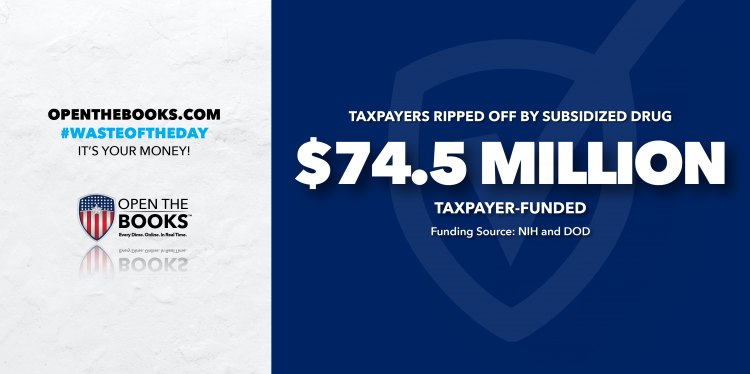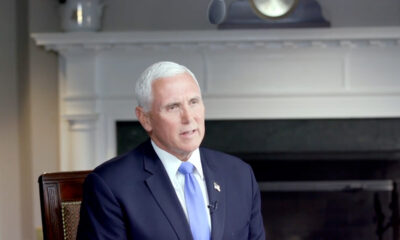Executive
Waste of the Day: Taxpayer-Funded Cancer Drug Costs Almost $200,000
Taxpayers paid millions to help develop a cancer drug, but that drug still costs nearly $200,000 per dose, which Medicaid and insurers have to cover. (Shades of the Ethical Dilemma of Heinz Stealing the Drug!)

Topline: Taxpayers spent $74.5 million to help develop the prostate cancer-fighting drug Xtandi, but its sky-high sticker price is limiting access to patients and siphoning money away from Medicaid, according to experts interviewed by Oncology News Central.
Tale of the super-expensive cancer drug
Key facts: The University of California, Los Angeles helped develop Xtandi in 2012 using government grants from the National Institutes of Health and Department of Defense.
The early research funded by taxpayers was the riskiest investment phase, since no one was certain if the drug would work, Dr. Bishal Gyawali of Queen’s University told Oncology News Central.

Once the risk was over, large pharmaceutical companies began investing in Xtandi. The drug’s list price has since reached $189,900 annually. The companies are making an average profit of $14.50 for every $1 they invested in Xtandi and other drugs, according to a World Health Organization study cited by Gyawali.
Medicaid is often forced to pay the high sticker price to help patients get the life-saving medicine.
There are also patients with incomes too high for Medicaid coverage who still cannot afford Xtandi. One cancer patient made a social media post stating that he was forced to forgo Xtandi treatment because it would cost him $2,300 per month after insurance.
The problem is seemingly unique to America. Xtandi costs $25,000 in Japan, $31,000 in Australia and $32,000 in Canada. The U.S. cost is also three to five times higher than in the United Kingdom, France, Italy, Germany and Spain, Oncology News Central reported.
A pharmaceutical spokesperson told Oncology News Central that 87% of Xtandi patients pay $50 or less, but the news outlet cited a study showing that the median annual cost for Medicare patients is actually $11,626.
NIH didn’t use its march-in authority
Search all federal, state and local government salaries and vendor spending with the AI search bot, Benjamin, at OpenTheBooks.com.
Background: In 2016, the Union for Affordable Cancer Treatment sent a petition to the National Institutes of Health asking the agency to help lower the price of Xtandi.
The federal government’s “march-in” authority, which has never been used, allows it to let other companies develop a drug if the patent holder does not make the medicine reasonably available to the public. The law only applies to drugs developed with taxpayer funds.
The NIH made a final decision in 2023, opting not to exercise its power.
Summary: Government-funded research should be utilized to help as many people as possible, giving the taxpayers who paid for the research the best return on investment.
The #WasteOfTheDay is brought to you by the forensic auditors at OpenTheBooks.com
This article was originally published by RCI and made available via RealClearWire.
Jeremy Portnoy, former reporting intern at Open the Books, is now a full-fledged investigative journalist at that organization. With the death of founder Adam Andrzejewki, he has taken over the Waste of the Day column.
-

 Civilization4 days ago
Civilization4 days agoDC Pipe Bomb Arrest Raises Questions About Christopher’s Wray’s FBI
-

 Civilization5 days ago
Civilization5 days agoThe Legal Logic Behind U.S. Operations Against Narco-Terrorist Networks
-

 Executive5 days ago
Executive5 days agoNewsom’s ‘National Model’ for Homeless Wracked by Fraud
-

 Executive2 days ago
Executive2 days agoWaste of the Day: Obamacare Failed Test, Approved Fraudulent Subsidies
-

 Executive4 days ago
Executive4 days agoWhen You’re in a Hole, Stop Digging
-

 Education3 days ago
Education3 days agoWaste of the Day: Taxpayers Subsidize Football Coach Severance
-

 Civilization3 days ago
Civilization3 days agoPence Calls on Trump To Fire RFK Jr Over Abortion Drug
-

 Civilization2 days ago
Civilization2 days agoWSJ’s Fearmongering Doesn’t Survive Contact With Evidence




